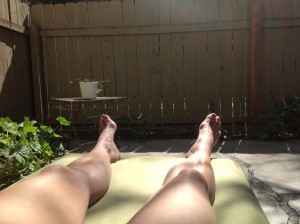I’ve posted at length here and on my FB Page about the importance of Vitamin D3, but I haven’t tackled the topic of sun exposure to any depth. Let’s explore this under-valued and misunderstood source of nutrients for body and mind, shall we?
Life would not exist on earth without the Sun. It is essential for almost all plant and animal life and is our primary source of energy (petrochemicals are based on fossilized plants.) Pastured animals who get lots of sun have higher levels of D3 in their meat, eggs and dairy. Good for them, good for us!
My dog will preferentially lay in the sun, even in 90 degree weather, for about 20 min every day. Smart pup.
Over the last sixty years, the medical establishment has warned people so much about the dangers of sun exposure (melanoma) that many avoid the sun at all costs. Many folks are missing out on the benefits that judicious sun exposure/Vitamin D sufficiency can confer, including reducing the risk of melanoma.
Only recently have the benefits of Vitamin D3 and other benefits, (like reducing blood pressure) of sun exposure been talked about in the press.
The Vitamin D Council website lists many more benefits:
1. Enhances mood and energy. ‘Nuff said!
2. Treats skin diseases like lupus vulgaris, psoriasis, vitiligo, atopic dermatitis and localized scleroderma.
3. Relieves pain in fibromyalgia.
4. Skin barrier functions. Skin exposed to UVB and UVA is more resistant to primary irritants.
5. Protects from disease beyond vitamin D? In an animal model, researchers discovered that sun exposure is more protective and suppressive against multiple sclerosis than just vitamin D alone.
6. Induces nitric oxide. UVA exposure induces nitric oxide (NO*) production. It has been suggested that NO* protects the skin for 20-30 minutes from UV damage, offers cardiovascular protection, helps wounds and have some anti-tumor activity.
How can we get these benefits and avoid increasing our risk of melanoma?
Here are some tips:
1. On a clear day, if your shadow is shorter than your height, you are likely to be making D3 from sun exposure.
2. The optimal time for more UVB rays (the ones that trigger D3 production) and fewer UVA rays (the type that cause cancer.) is between the hours of 10 and 2 (adjust for Daylight saving time.)
3. Your complexion determines how long you need to expose your skin to make the maximum amount of D3 in a day. See this scale to know where you are. The higher the number, the longer you need to stay out.
4. Generally speaking, lighter-skinned people can get enough sun by staying out until their skin is just slightly pink. Darker skinned people need more time. For example, I am Type IV on the Fitzpatrick scale and need four times the exposure as my Type I husband.
5. Higher latitudes mean a lower angel of sunlight and hardly any Vitamin D production in the winter. If you live above 38 degrees latitude, you will want to use a decent tanning booth or supplement D3 in the winter. Or head to a southern beach if you can afford it!
6. After sufficient exposure, cover up instead of using sunscreen. If you need to use sunscreen make sure it is a safe one.
Get Sun smart and catch some optimal rays! Your body, mind and spirit will thank you.

Great advice! I crave the sun if I don’t get much exposure for a few days. Our dogs, cats and chickens all love to lie out in the sun for a few minutes (or many minutes) daily.
Thanks, Jean Marie!